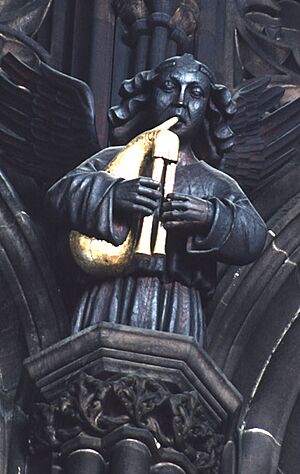English bagpipes facts for kids

Bagpipes are ancient musical instruments. They have been played for a very long time. It's not clear exactly when bagpipes first came to England. Some clues suggest they might have been here during Anglo-Saxon times. However, the oldest definite proof of bagpipes anywhere in the world comes from the 1200s. Two of these proofs are from England. One is a book called the Tenison Marginalie Psalter from Westminster. The other is a record of King Edward I buying a set of bagpipes. The third proof is from a Spanish book called Cantigas Del Santa Maria.
From the 1300s onwards, bagpipes started appearing more often in European records. Interestingly, about half of these mentions are from England. This suggests that bagpipes were quite common in England back then.
Bagpipes are even mentioned in famous English literature. One of the earliest mentions is in The Canterbury Tales by Geoffrey Chaucer. He wrote this book in the late 1300s. In the introduction to the story about the Miller, Chaucer wrote:
A baggepype wel coude he blowe and sowne,
And ther-with-al he broghte us out of towne.
This means the Miller was good at playing the bagpipe. He even played it as they left town.
Stone and wood carvings of bagpipes also started to appear. You can find these carvings in English cathedrals and churches. This began in the 1300s. Examples can be seen in places like Cornwall, Dorset, Devon, Herefordshire, Yorkshire, Cambridgeshire, Manchester, Norfolk, and Shropshire.
Bagpipes became more and more popular across England and Europe. This happened from the 1400s to the 1600s. During a time called the Baroque era, instruments became more advanced. Bagpipes also got better and more complex. They also became smaller and quieter. People started to prefer these smaller "parlour pipes." The big, loud bagpipes from medieval times slowly disappeared.
By the 1600s, a type called Pastoral pipes was very popular in England. These pipes were even taken to Ireland by English settlers. In the 1800s, bagpipes lost a lot of their popularity in most of Europe, except for Scotland. Many piping traditions died out. But luckily, they were reborn in the 1900s.
Today, the only continuous English bagpipe tradition is the Northumbrian smallpipes. These are still played in Northumberland and Durham. Also, the Border pipe tradition, which is similar, has been brought back to life. This tradition is found in Northern England and Lowland Scotland.
Anglo-Saxon Bagpipes
Bagpipes are mentioned in ancient Greece and Rome. But then they seem to disappear from history for a while. They show up again in medieval Spain and England. From there, they quickly spread across parts of medieval Europe. There's one interesting exception to this gap in history. The only possible mention of bagpipes during the Dark Ages is in England.
The Exeter Book of Riddles is a collection of old English writings. It contains a riddle where the answer is "Bagpipes." Also, some Anglo-Saxon musical instruments were found in York, England. Among them was a reed pipe. Some experts think it might have been part of a bagpipe. However, it's hard to be sure. Other instruments, like bladder pipes, also used reed pipes.
Regional English Bagpipes
Different parts of England had their own types of bagpipes. Here are a few examples:
- Lancashire: The Lancashire bagpipe was also known as the Lancashire greatpipe. It is mentioned in old writings. People even believed that the Lancashire bagpipe could protect against witchcraft!
- Leicestershire: The Leicestershire smallpipes have been recreated many times. A pipemaker named Julian Goodacre has made many copies since the late 1900s.
- Lincolnshire: The Lincolnshire bagpipes are mentioned in literature, even by Shakespeare. In 2010, new sets of these bagpipes were made. They were based on pictures found in churches in Lincolnshire.
- Yorkshire: The Yorkshire bagpipes are mentioned in old writings. However, this type of bagpipe no longer exists today.
- Worcestershire: The Worcestershire bagpipe is also mentioned in literature. People from this county were known for loving to play the pipes. This instrument also no longer exists.
Other British Isles Bagpipes Being Rebuilt
Some other types of bagpipes from the British Isles are being rebuilt or revived:
- Cornish bagpipes
- Welsh pipes (some physical examples from the 1600s and 1700s still exist)
- Zetland pipes
- Scottish smallpipes

